Why the daylily does not bloom
If you planted a daylily, it grows every year, but does not bloom, then you may have made mistakes when planting, taking care of or choosing a variety of this perennial. Daylily grows rapidly and produces many new layers per year with a large amount of nitrogen in the soil. However, the active growth of green mass is at the expense of flowering. For the flowering of the daylily, phosphorus-potassium fertilizer or complete mineral fertilizer must be applied, and organic fertilizers with manure or herbal infusion must be completely excluded.
The daylily will not bloom or produce few peduncles when planted in the shade. Having transplanted the plant to a more sunny place, the daylily will bloom in full force. The daylily does not bloom during deep planting if the root collar of the plant is more than 2 cm below the soil level.
Some varieties of daylilies may not be suitable for the climatic zone when grown in regions with frosty winters. First of all, these are evergreen daylilies, they can survive at low temperatures, but they will not have the strength to bloom. Daylilies may not bloom in hot and dry summers due to lack of moisture and heat stress, during which time the plants need regular abundant watering.
Another reason why the daylily does not bloom is pest or disease. Daylily can attack thrips or spider mites, these insect pests are difficult to see due to their small size, but they actively reproduce mainly in hot and dry summers. With a combination of adverse conditions and attack by pests, plants quickly weaken. To get rid of pests, systematic treatment with insecticidal preparations will help. To heal the daylily, cut the foliage in half to stimulate the growth of new leaves.
It happens that flower stalks come out of the daylily, buds are formed, but they fall off without opening. This usually happens in cold and rainy summers, when the average daily air temperature does not reach +18 degrees.

Planting a daylily in open ground
What time to plant
Such flowers are planted in spring, summer and autumn, the exact time of planting directly depends on the climate in your region. In the event that winter in the region comes rapidly and very early, then the daylilies planted in autumn may not have time to adapt to new conditions before frost, because they take about 4 weeks to root. However, in the event that garden forms were chosen for planting, in which the flowering period is medium or early, then in middle latitudes they can quickly take root and prepare for winter. You can also protect plants from freezing by sprinkling the area with a layer of mulch.
Experienced gardeners recommend planting a daylily in the open ground in the middle lane in May or August. It is also necessary to divide or transplant in the spring or at the end of summer.
How to plant
Before proceeding with the planting of planting material purchased at the store, it must be immersed in water or in mineral fertilizer, which must be strongly diluted, for several hours
From this, the roots will become swollen and come to life, in which case you can easily select unhealthy roots and carefully remove them. The remaining roots must be shortened to a length of 20 to 30 centimeters
For each bush or delenka, a separate planting hole should be prepared, the depth of which should be about 0.3 m. Also remember that this flower will grow in one place for a long time, and during this time it will grow in diameter up to 0.5-0, 7 m, so try to leave such a distance between the bushes so that they are not crowded.A soil mixture consisting of peat, sand and humus must be poured into each of the prepared holes, then add phosphorus-potassium fertilizer or wood ash mixed with superphosphate
Then the root system of the plant must be placed in the hole and carefully spread it, while making sure that there is no empty space under it. After that, fill the hole with soil, but not to the top.
Then, holding the bush with your hand, tamp the soil well and pour enough water into the hole so that it is full. In the event that the liquid is quickly absorbed into the soil, then this means that the earth is poorly compacted, so pour dry soil into the hole and compact it well again. Then you need to fill the hole to the brim with soil. When planting, make sure that the root collar of the flower is not more than 20-30 mm deep into the ground, otherwise growth retardation and the appearance of rot may occur. If you planted a daylily, observing all the rules, then there should be enough water in the holes for the bush for complete rooting.
Transfer
You can grow such a flower in the same place for about 15 years, but over time, the quality of flowering will deteriorate. If you see that your previously luxurious and already middle-aged bush has become less effective (the flowers have been crushed, and there are fewer of them on the peduncle), then this means that it is time for a transplant. To begin with, dig in a bush along its outer border and carefully remove it together with an earthen lump, while trying not to injure the roots
The root system must be flushed out with a garden hose and then carefully divided into individual fans. If you have certain skills, then you can divide the bush with your hands, but if you use a knife or pruner, then the cut points must be treated with a fungicide
It is recommended to plant and transplant on a cloudy day, but if you have to wait for the right weather for a long time, then it is recommended to dig the bushes or delenki in the sand, they can stay there for about half a month. Before planting a copy, you need to shorten the roots, and you should also cut off all dead and rotten ones. Then trim the leaves to a height of 15–20 centimeters in the shape of an inverted V. Put the prepared cut in a permanent place.
Hybrid garden varieties
The number of hybrids exceeds 60 thousand. The varietal variety of daylilies is explained by scientific advances that occurred in the middle of the 20th century. Breeders were able to learn how to double the number of chromosomes in a plant: from 22 to 44.
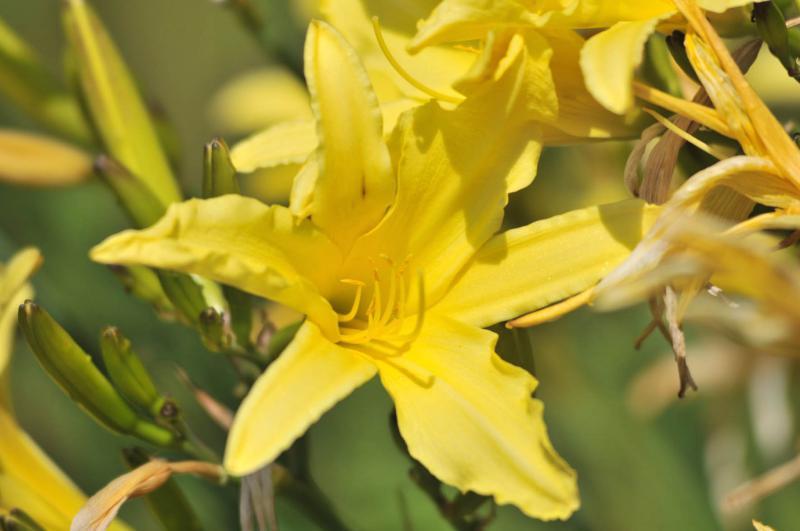
The advent of tetraploids (TET), daylilies with 44 gene structures, created unlimited conditions for the development of new varieties.
Differences between TET and diploids (with 22 genes):
- the largest flower;
- bright color;
- the strength of the stems.
TET daylilies can bloom 2 times per season in warm weather in late summer and early autumn. The interval after the main growing season is up to 2-3 weeks, after which a new arrow begins to grow. The advantages of DIP are the sophistication of the flower shapes.
The classification of plants, which determines the decorativeness of varieties, concerns:
- forms;
- bud size;
- the height of the flower arrows;
- presence of aroma.
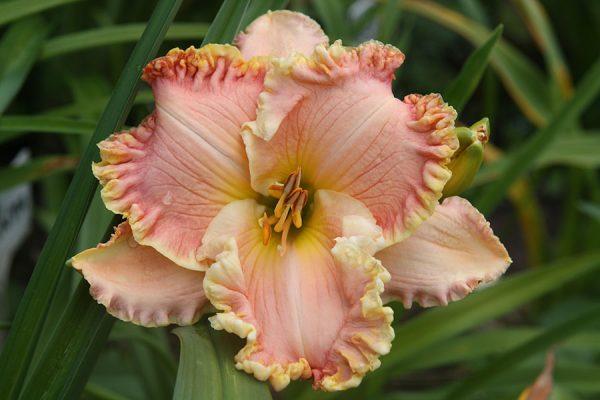
For example, by flower size, daylilies are grouped into 3 categories:
- up to 75 mm - mini;
- 75-115 mm - small;
- from 115 millimeters - large.
The shape of the flower is determined by the length, width of the petals, and their relative position. The number of flowers with the declared shape must exceed 50% of all buds on the daylily bush.
Double
Daylilies with the word "double" in their names have two or three sepals. According to the classification, this is a flower of a simple form. Each sepal has 3 petals. An open flower, depending on the projection of the gaze, can appear round, triangular, tubular, in the form of a star.
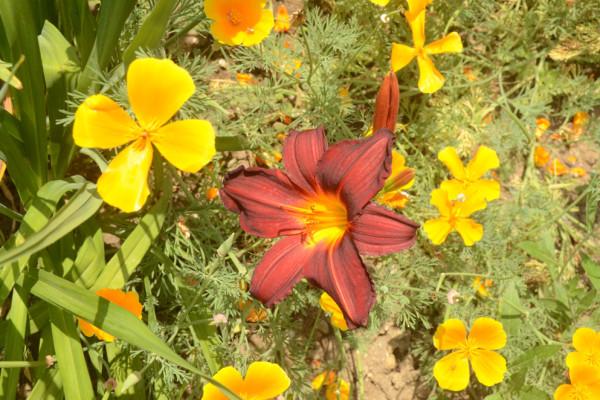
Spiders (spider-like)
In daylilies with arachnid petals, the ratio between the length and width of the petal is at least 4: 1. When leaving the neck, they do not come into contact with each other. Spiders are large-flowered daylilies.
Polymers
The number of petals and sepals exceeds the number of stamens from which additional petals can emerge.

Fragrant
By their ability to aromatize the air, daylilies are subdivided into odorless, aromatic and highly aromatic.
Dwarf and undersized
By the height of the flower arrows, lily varieties are divided (meter):
- on dwarf ones - up to 0.3;
- undersized - up to 0.6;
- medium-sized - up to 0.9;
- tall - over 0.9.

Small sizes have nothing to do with the size of flowers. Low clumps can be covered with large buds. Such varieties are used to create alpine slides in landscape design or are grown in flowerpots.
Terry
In double daylilies, part of the stamens is reborn into petals, which gives a multilevel bud. Such a flower looks like a peony or two flowers in one.
The best varieties of daylily with photo names and descriptions

Daylily hybrid Frans Hals Frans Hals photo of flowers
Frans Hals - plant height 60-80 cm, the peduncle ends with yellow-orange corollas with a wavy edge, the diameter is 12-15 cm.

Daylily Bonanza Hemerocallis Bonanza photo
Bonanza - in the center of the yellow corolla there is a sputtering of a wine-red shade. Differs in regular flowering, high frost resistance.
There are varieties of daylilies whose inflorescences resemble gladioli in appearance:
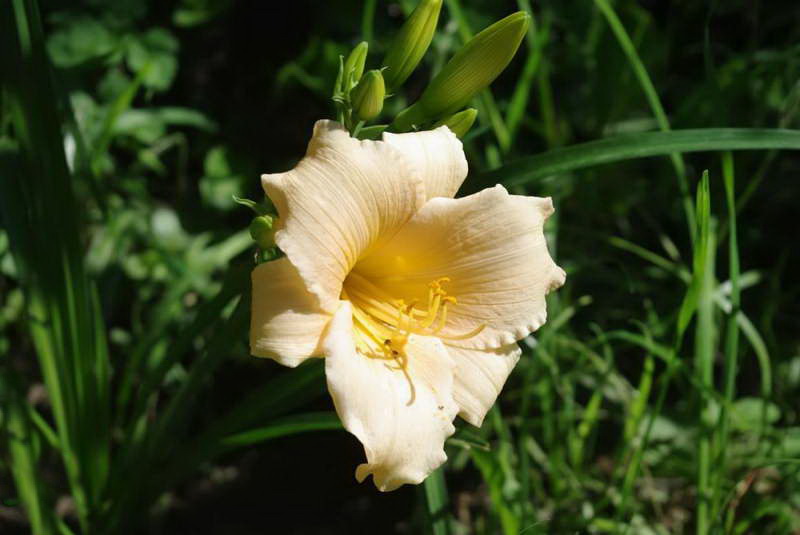
Daylily 'Longfields Pearl' Longfields Pearl photo
Longfields Pearl - creamy yellow flowers bloom in August, delighting until mid-autumn. The diameter of the corolla is 10 cm.

Daylily Stella De Oro Stella De Oro photo
Stella De Oro - the height of the bush is 30-40 cm. The yellow corollas are 6-7 cm. It has a long flowering period. The crumb will become a real star of the garden: undersized bushes will look spectacular along the paths, in border plantings.
New varieties of daylilies:
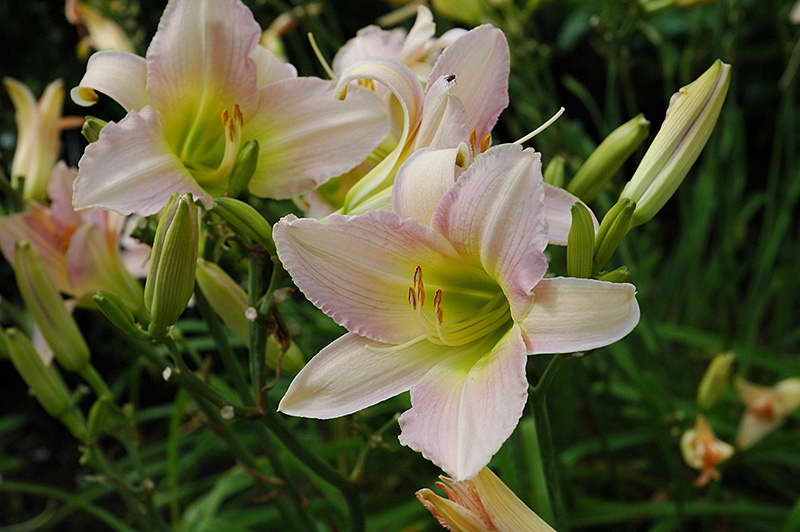
Daylily Katerina Woodbury Catherine Woodbery photo
Catherine Woodbery - the petals of a classic daylily shape have a quivering lilac hue that changes depending on the lighting (under the bright sun it becomes pink-yellow, and in shade it shows a lilac-pink sophistication). Diameter - 12-16 cm.
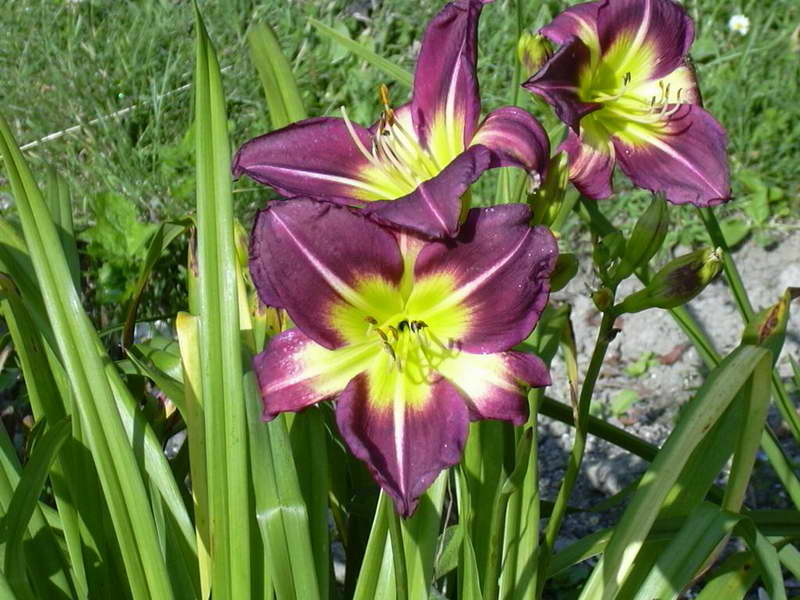
Daylily Night Bacon Night Beacon photo
Night Beacon - a colorful contrast of the yellow-green heart and purple petals, does not fade under the sun. Corollas reach a diameter of 8 cm.

Daylily Double River Wye Hemerocallis Double River Wye photo
Double River Wye - terry corollas with a diameter of about 12 cm, the color is rich yellow.
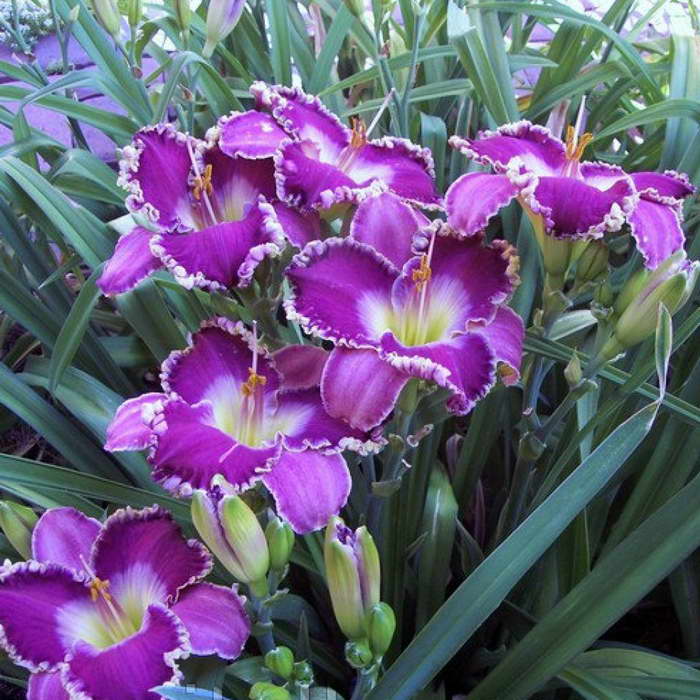
Daylily bestseller Hemerocallis Bestseller photo
Bestseller - the height of the bush is 60-70 cm. Large corollas (14 cm in diameter) impress with their shape and color. They are simple, but along the edges of the pink-purple petals there is a convoluted frill of a greenish-yellow hue.
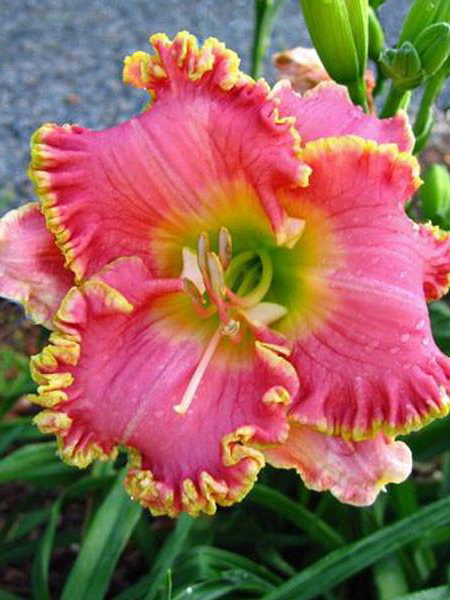
Daylily Divas Choice Hemerocallis Diva's Choice photo
Diva's Choice - in the back of the neck there is a spot of a creamy yellow hue, smoothly turning into pink-cream petals, which becomes salmon-coral as it blooms. The record diameter of inflorescences is 17 cm. One peduncle holds 3-4 corollas.
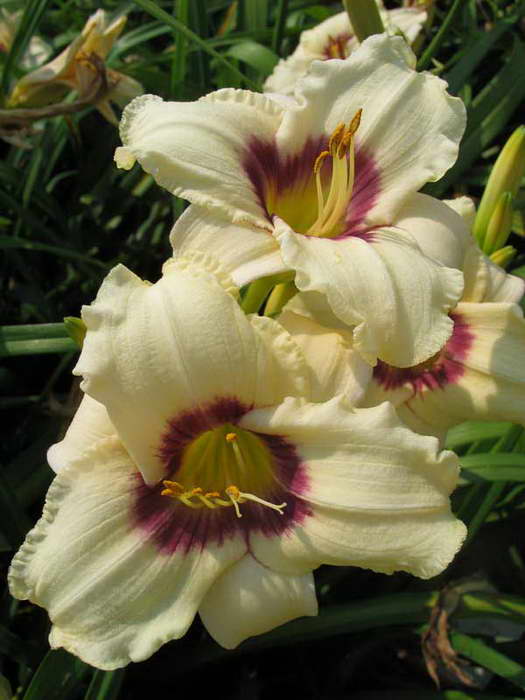
Daylily Pandoras boxing Hemerocallis Pandora’s box photo
Pandora's box - with a half-meter height of the bush, pleases with inflorescences about 10 cm in diameter. The neck of the corolla is lime-colored, then the bright middle is like a handful of ripe cherries, ending in pastel-yellow petals.
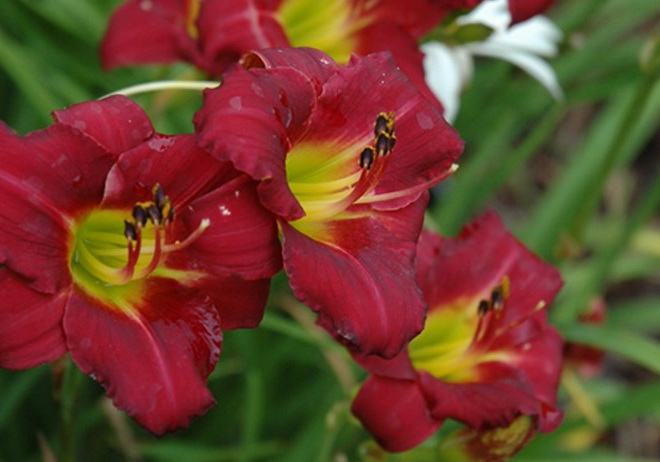
Daylily Pardon Me Hemerocallis Pardon Me photo
Pardon Me is the leader among low growing varieties. Blooms from June to late September. The neck is a lime shade, the petals are dark cherry color.
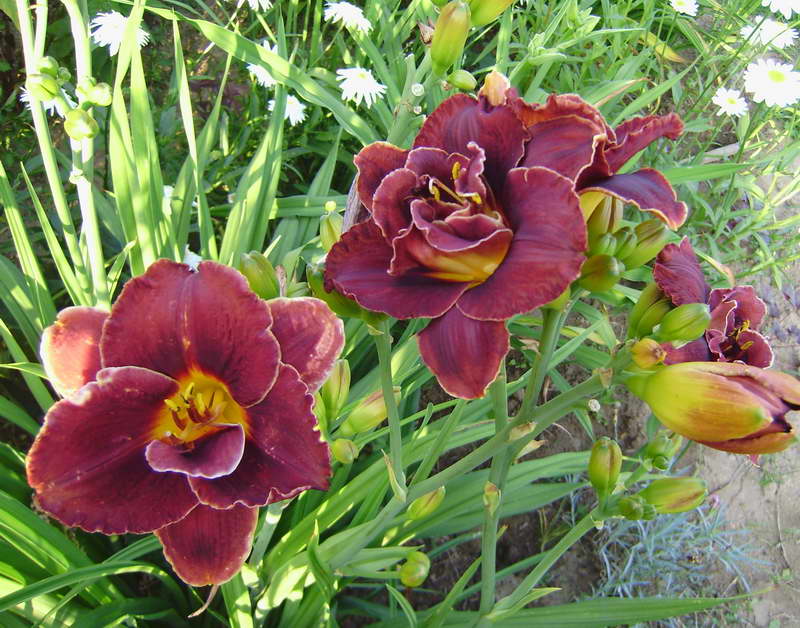
Daylily Night Embers Hemerocallis Night Embers photo
Night Embers - the height of the bush is 75 cm. Corollas are double, 12-15 cm in diameter. The petals seem to be velvety, raspberry-wine shade.

Daylily Lacy Doily Hemerocallis Lacy Doily photo
Lacy Doily - the bush is 60-80 cm high. Graceful double flowers have a pale pink tint.

Daylily Double Dream Hemerocallis Double Dream photo
Double Dream is truly a dream. Huge (15 cm in diameter) terry corollas from creamy to salmon shade. It blooms early, is ready to grow in the sun, tolerates the absence of a strait, is not afraid of frost.
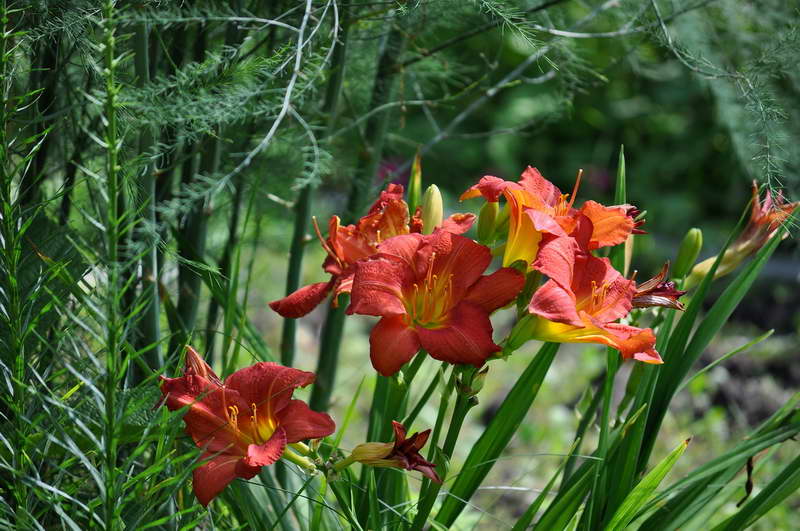
Daylily Red Rum Hemerocallis Red Rum photo
Red Rum - scarlet inflorescences with a diameter of 10 cm delight in the period June-August.
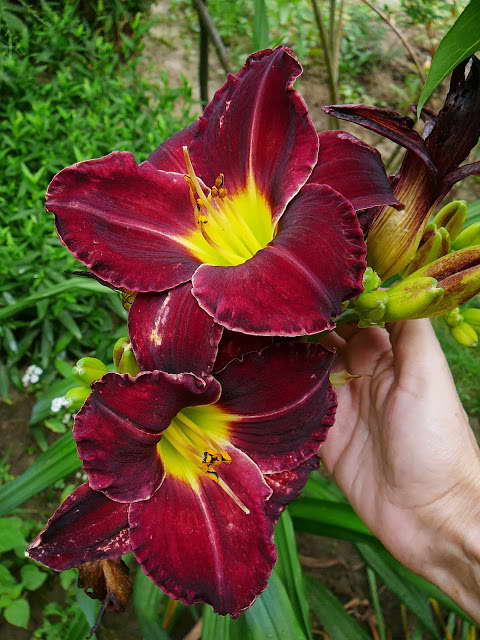
Daylily Black Stockings Hemerocallis Black Stockings photo
Black Stockings - new (launched 2015). Striking with a corolla diameter of 15 cm and a purple-violet shade of the petals, the yellowish core illuminates from the inside. The edges of the petals are corrugated.
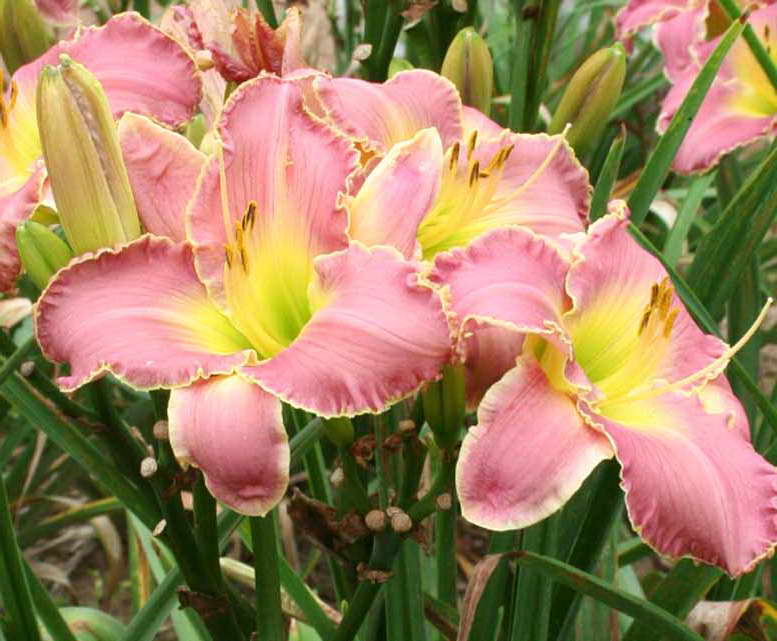
Daylily Little Anna Rosa Hemerocallis Little Anna Rosa photo
Little Anna Rosa - miniature 40 cm tall, corolla diameter - 8 cm. Rich lemon-colored core, pale pink petals with corrugated edges. Has 2 flowering waves.
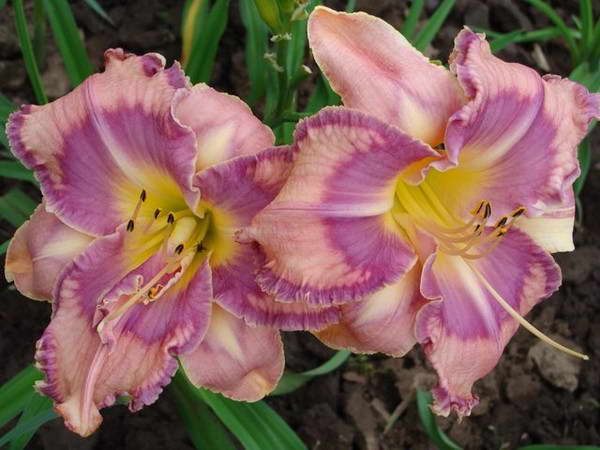
Daylily Mildred Mitchell Hemerocallis Mildred Mitchell photo
Mildred Mitchell - huge corollas (18 cm in diameter) open in June-July, repeating flowering in autumn. The most delicate colors, in pink and purple tones.
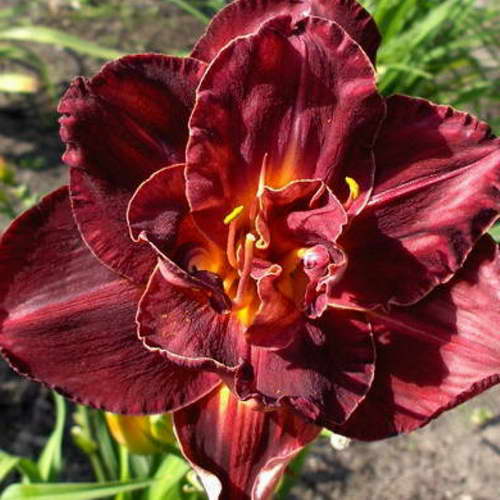
Daylily Burgundy Love Hemerocallis Burgundy Love photo
Burgundy Love - 2-3 waves of flowering can be expected from it. The corrugated petals have a noble burgundy hue.
Popular species and varieties
On sale you can find many types and varieties of daylily. Some of them, like TET daylilies, can bloom twice in the same season. The plant blooms in early summer, and then, after resting for 2-3 weeks, it can again release a flower arrow.

Daylily hybrid
This group of plants includes varieties with early, mid and late flowering periods.
According to the botanical classification, hybrids are also divided into three groups:
- sleeping;
- evergreen;
- partly evergreen.
These plants can have a wide variety of flower shapes. The buds are round, star-shaped, fringed, triangular, double. The diameter of the flowers of this species can reach 20 cm, and the color of the petals in different varieties has 18 shades.

Daylily hybrid hemerocallis
The hybrid daylily hemerocallis is an evergreen species. This group includes 20 natural hybrids:
- Forest,
- Dumortier,
- small,
- folded,
- Thunberg,
- eesky and others.
For high-quality flowering, these varieties need planting in a sunny place. It is under such conditions that the varietal qualities of hemerocallis hybrids are fully revealed. For planting in the middle lane and cold regions, it is necessary to select only frost-resistant varieties with early and medium flowering periods.
Daylilies Voroshilova
A well-known breeder of daylilies in Russia is Voroshilova A.B. She bred dozens of varietal plants of all kinds of color and degree of terry.
An unusually beautiful variety "Monarchia" with corrugated pale pink petals. Closer to the center of the flower, crimson strokes stand out, the middle is yellow.
The variety "Moonlight Sonata" has an ocher color, the edges of the petals are wavy, curling towards the center. Voroshilova's daylily "Umka" looks very gentle. Its large flowers are lemon-white in color and have a light green center. The petals of the plant are very dense.
Variety "Stella de Oro"
The Stella de Oro daylily variety is distinguished by its increased winter hardiness. The plant is suitable for planting even in cold climates, therefore it is popular.
The shrub is compact in size, its average height is 40-50 cm. The flowers can be yellow and orange in color, emit a light pleasant aroma. The size of the opened buds is 5-6 cm. Flowering lasts from June to September continuously. Narrow linear leaves emphasize the beauty of the flowers.
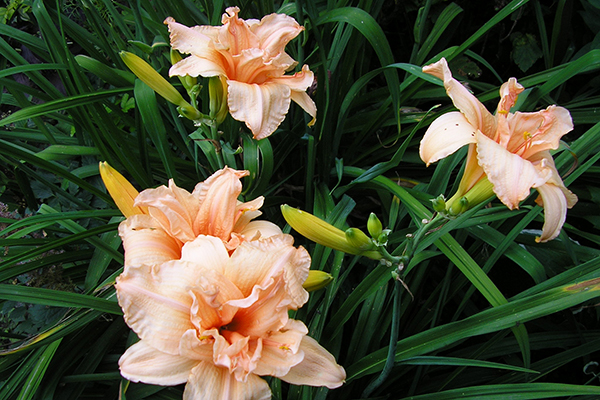
Variety "Double Dream"
The Double Dream hybrid daylily grows up to 50-60 cm in height. The plant is distinguished by unusually delicate double flowers of salmon color. Flowering occurs in 2 waves and is characterized as abundant. The shrub opens its buds between July and August. The maximum flower diameter is 12 cm.
The variety winters well in any region when using mulch as a shelter.
Daylily home
Daylily can be grown indoors. Not every variety is suitable for this. Usually, the daylily is chosen for planting red, lemon yellow, small and other compact species.
The most important condition for a home daylily to bloom is good lighting.With a lack of light, the flowers will be small or will not bloom at all.
In spring, during active growth, the daylily is fed with mineral fertilizers. You need to water the plant occasionally, with small doses of water. When watering, moisture should not get on the flowers. An overgrown plant needs a transplant. The bush is planted in the garden between May and August. It is better not to transplant flowering plants; transplanting will weaken them.
Flower color
All sorts of shades and color combinations make the daylily very attractive for our climate, where bright colors are so lacking. To date, there are no daylilies only of pure white and pure blue colors, although American breeders are quite successfully moving in this direction. Almost white varieties become whiter every year, and there are already plenty of varieties with blue and blue eyes. They are especially pronounced in cool and cloudy weather.
The main colors of daylilies:
- yellow (Yellow) - all shades from pale lemon, through bright yellow and gold to orange.
- red (Red) - various shades of scarlet, carmine, tomato red, maroon, wine red and black and red.
- pink (Pink) - from pale pink through deep pink to pink-red.
- purple (Purple) - from pale lavender and lilac to dark grape or purple.
- melon or cream-pink (Melon or Cream-Pink dotfrom) - from pale cream shades to dark melon. Brown, apricot, and peach are considered variations of pink plus yellow. White daylilies can be tints of yellow, pink, lavender or melon.
The daylily flower in its color can be:
- monochromatic (Self) - the petals and sepals are the same color, but the stamens and throat may be of a different color.
- multicolor / polychrome (Polychrome) - a mixture of three or more colors, such as yellow, melon, pink and lavender, without a clear rim above the throat. The stamens and throat may be of a different color.
- bicolor (Bicolor) - inner and outer petals of different colors (dark top, light bottom). And also reverse bicolor (Reverse Bicolor).
- two-tone (Bitone) - outer and inner petals of different shades of the same base color (top - a darker shade, bottom - lighter). And also reverse two-ton (Reverse Bitone).
The petals of many modern hybrids shine and sparkle in the sun. This effect is called "sputtering". A distinction is made between Diamond Dusting, Gold Dusting, and Silver Dusting.
Which daylily to plant: the best varieties
When choosing a variety of daylily for planting, note that there are early, medium and late flowering species. Such an assortment will allow us to decorate the site with magnificent and bright flowers that bloom from spring to autumn.
Daylily grade Strutter's Ball
Daylily "Strutter's Ball" is a very popular variety of daylily, the flowers of which look like luxurious purple bells measuring 15 cm. The bush is up to 1 m in height. Blooms closer to mid-July with 15-centimeter flowers. The petals are dark cherry, with a bright yellow stripe that runs from the center of the flower to the tip of the petal. It blooms for 1-1.5 months. Reproduces well. With such a flower, your flower bed will not go unnoticed.
Daylily variety Strawberry Candy (Strawberry candies)
Strawberry Candy is an early variety. Bushes up to 70-75 cm in height, flowers up to 11 cm in diameter, - with wide corrugated petals along the edge. The middle of the flower is bright yellow, the tone of the petals closer to the center is rich strawberry, gradually turning into caramel. Blooms for the first time at the end of June, and again at the end of August. Strawberry Candy has won numerous medals and awards in the United States.
Daylily grade Stella D'Oro (Stella D'Oro)
Stella D'Oro flowers adorn the garden from May to mid-autumn. The plant is undersized (up to 35-40 cm in height), but, at the same time, it is distinguished by abundant long flowering. The flowers are lush, up to 6-6.5 cm in diameter, rounded, yellow-golden hue.The petals are densely planted, with a beautiful corrugated edge. The drooping leaves are highly decorative, light green in color. Daylily "Stella D'Oro" was bred in 1975 by an amateur florist V. Yablonsky.
Daylily Siloam Double Classic grade (Siloam Double Classic)
Daylily "Siloam Double Classic", which is known for its sweet aroma, blooms in early summer with large apricot-pink double flowers, 10-12 cm in diameter. The flowering period lasts all summer. Bushes 50-70 cm in height. The winner of numerous competitions, the variety was awarded the highest award in the most prestigious international competition for daylilies, Stout Medal.
Daylily cultivar Double River Wye (Double River Wye)
Terry flowers, rich lemon shade. The variety is distinguished by long flowering - from late July to early October. Bushes up to 1 m in height, flowers up to 14-15 cm in diameter. Up to 20 flowers are usually formed on 1 peduncle. The leaves are rich green, highly decorative, adorn the site throughout the season. The variety is very popular with landscape designers.
Daylilies go well in a flowerbed with hosta, phlox, irises and lilies. Knowing the rules for growing a daylily - planting and simple care, you will receive a flower that will only delight you all season.
Daylily - a flower with character
Spiders themselves, as well as varieties of an unusual shape, are very diverse. The petals are twisted along (‘Magic of Oz’) or falling, like in the ‘Judge Roy Bean’. New items with corrugated and scalloped edges ('Heavenly Beginning1) appear.
The palette and drawing are becoming more intricate every year. Unusual varieties with an almost white, almost black and almost green color appeared.
The flower diameter sets record after record, having crossed 25 cm long ago. In some daylilies, it reaches 30 (‘Jan’s Twister’) and even 35.5 cm (Long Tall Sally ’).
Many spiders bloom for a long time, sometimes the flowers last for almost two days, even in hot weather. American growers also note that spiders are more drought tolerant.
Recently, American breeders have succeeded in converting many old (diploid) varieties into tetraploid forms. The advantage is obvious: many spiders, which previously had a significant drawback - weak peduncles, which lodged under the weight of blossoming flowers, gradually "get on their feet"! Famous varieties such as ‘Sergeant Major’, ‘Firebird Suite’, ‘Mint Octopus’ (UFO), now not only bloom beautifully and profusely, but also hold tight.
The newest trend is the breeding of terry daylilies with a spider-like flower shape. They belong to a group of unusual shapes, but collectors often call such varieties "terry spiders". In this area, Ian Joyner, the creator of the fantastic daylilies 'Airy Delight', 'Fashion Leader', 'Feminine Fingers', 'Fluttering Beauty', 'Firefly Frenzy' (also fragrant!), 'Sebastian The Crab', 'Tickle My Fancy'.
For daylilies, not only beauty is important, but also the garden qualities of the variety - the ability to grow well, bloom profusely and for a long time, bloom early in the morning and hold out until night, not be afraid of cloudy weather. Unfortunately, not all foreign novelties perform well in our temperate climate - after all, almost all of them come from American nurseries located in the subtropics. Getting into the conditions of harsh winters and cool summers, they can show their drawbacks - low winter hardiness, inability to fully open flowers, susceptibility to discoloration or instability to fungal diseases.
When using such daylilies in garden design, you need to take into account the unusual outlines of their flowers. In addition, in most varieties, they are very large and, as a rule, there are few of them. Such extravagant plants can create a "tropical" effect. Their huge flowers resemble exotic plants, especially against the backdrop of large hosts or lush shrubs. You can plant daylilies - spiders as tapeworms or in small homogeneous groups.In the midst of flowering, they will make an extraordinary impression.
Daylilies after flowering
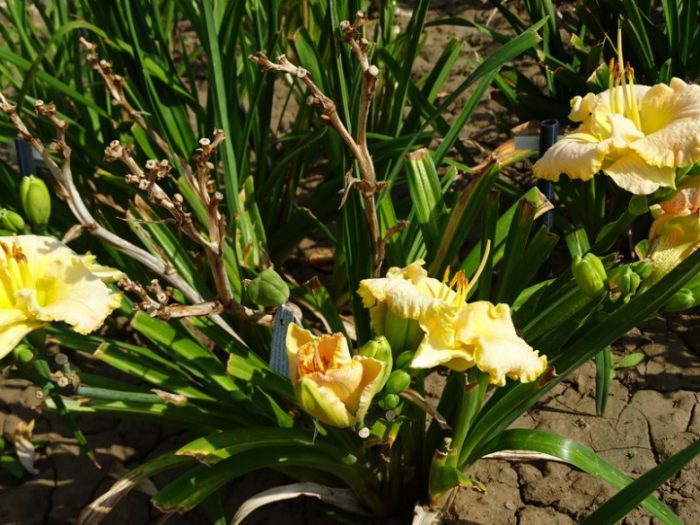
Daylilies are classified as deciduous (dormant), semi-evergreen, and evergreen.
Sleepers (Dormant)
In autumn, the leaf plates turn yellow and wither. The flower is dormant until the onset of spring.
Semievergreen
If the climate in the region is mild, then they are more similar in behavior to evergreens, and in areas with frosty winters, its leaves turn yellow, but they do not stop growing completely.
In deciduous plants, it is recommended to cut off the aerial part before winter, while the length of the remaining foliage should be about 15–20 centimeters. They do not need shelter, as they are frost-resistant. But in the northern and eastern regions of Russia, semi-evergreen and evergreen species most often freeze out during a winter with little snow, especially if the air temperature drops below minus 20 degrees. In this regard, in the fall, it is better to take care of the shelter of such daylilies, as well as recently planted bushes. You can cover with spruce branches, sawdust, dried foliage or straw. At the very beginning of spring, the shelter must be removed, since such flowers wake up quite early.


